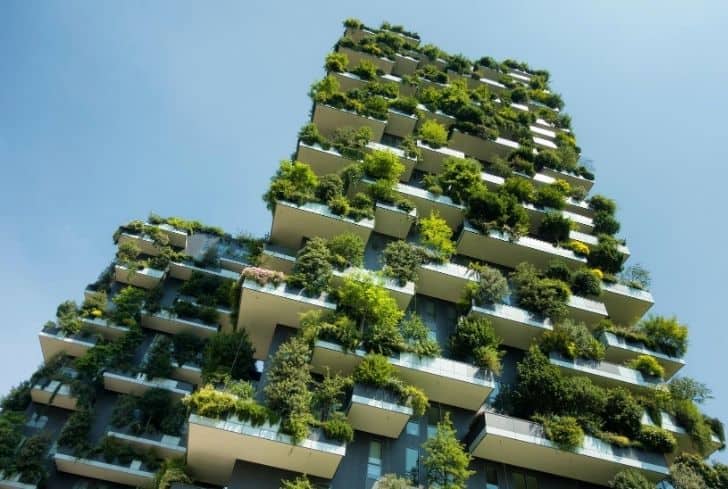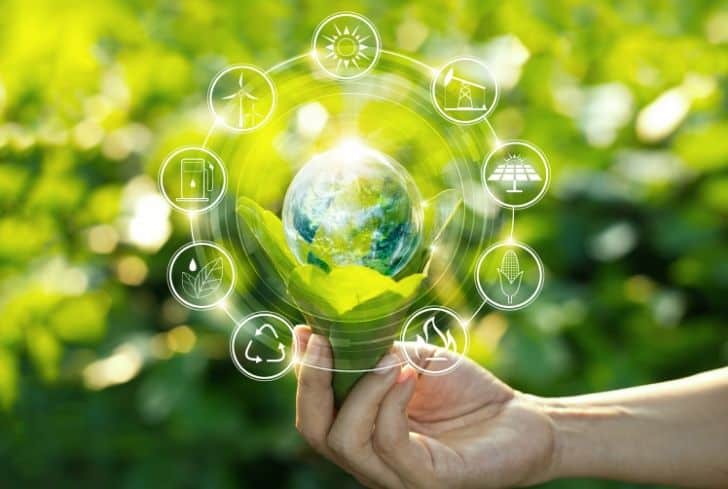COURTESY : www.conserve-energy-future.com/
Green builing
This day and age, you hear everyone talking about going green. Whether you want to admit it or not, at some point, everyone will have to follow with the green movement. This is because at the rate we are going, the earth is simply not sustainable. That means that over the years, we will begin to run out of certain natural resources that are needed for us to survive.
Indeed, that is alarming to some people, which is why there are so many people that focus on the green building today. But what exactly is green building? Let’s take a closer look at what it is, why you should consider it, and what the goals of a green building are. You are sure to find that it is something that you should take part in.

All I want is to stand in a field and to smell green, to taste air, to feel the earth want me, without all this concrete hating me.
~ Phillip Pulfrey
Contents [show]
Defining a Green Building
First, we will take a look at what a green building is. Some people may think of a green or sustainable building as just a building that doesn’t really have as bad of an impact on the environment as another ‘average’ building. Other people may find it to be the type of building and the actual surroundings of the building.
The ideal green building would be a building project that would allow you to preserve most of the natural environment around the project site, while still being able to produce a building that is going to serve a purpose.
The construction and operation will promote a healthy environment for all involved, and it will not disrupt the land, water, resources and energy in and around the building. This is the actual definition of a green building.
The U.S. EPA says
“Green building is the practice of creating structures and using processes that are environmentally responsible and resource-efficient throughout a building’s life-cycle from siting to design, construction, operation, maintenance, renovation and deconstruction.
This practice expands and complements the classical building design concerns of economy, utility, durability, and comfort. Green building is also known as a sustainable or high-performance building.”
See also25+ Terrific Reasons to Buy and Eat Locally Grown Food
Why Go Green?
Now, let us take a look at why it is so important to go green. Most people will find when going green that they are able to reduce their carbon footprint and actually lend a helping hand to the environment. You can go green in a variety of different ways, but builders and construction workers must do their part as well.
If you haven’t begun going green, then you will find that there are a variety of different things that you can do to help you get started. You don’t have to jump in headfirst, and you can actually take some baby steps along the way. Green buildings are designed in such a way to reduce the overall impact on the environment and human health by:
i. Reducing trash, pollution and degradation of the environment.
ii. Efficiently using energy, water and other resources.
iii. Protecting occupant health and improving productivity.
Does Going Green Really Cost You More?
Some people feel that they just can’t go green because it will cost them more money, but that is really a common misconception. While it may cost you a bit more to get started when you are going green, because green materials and products can be more costly, you really have to consider the type of savings that you will be able to reap.
You will be able to save on energy costs because going green also means conserving energy. You should really look at the green building as more of an investment than anything else. An investment that will be able to save you money, as well as an investment that will be able to help the environment! It is a win-win situation for everyone!
Benefits of Green Building
With new technologies constantly being developed to complement current practices in creating greener structures, the benefits of green building can range from environmental to economic to social. By adopting greener practices, we can take the maximum advantage of environmental and economic performance.
Green construction methods, when integrated with eco-friendly design and construction, provide the most significant benefits. Benefits of green building include:
Environmental Benefits
1. Reduces Wastage of Water and Energy
Green buildings certified by the Global Green Building Council (GGBC) results in water savings of 20 – 30% and energy savings of 40 – 50% compared to conventional buildings in India.
Green buildings achieving the Green Star certification in Australia have been shown to save 51% less potable water and produce 62% fewer greenhouse gas emissions than if they had been built to meet minimum industry requirements.
See alsoImportance, Technologies and Design Approaches Used in Green Building
Green buildings achieving the Green Star certification in South Africa have been shown to save between 20 – 30% potable water every year, and to save on average between 30 – 40% energy and carbon emissions every year, when compared to the industry norm.
Green buildings achieving the GGBC certification in the US and other countries have been shown to consume 11 percent less water and consume 25 percent less energy than non-green buildings.
2. Conserves Natural Resources
The building sector has the largest potential for reducing greenhouse gas emissions significantly compared to other major emitting sectors.
This emissions savings potential is said to be as much as 84 gigatonnes of CO2 (GtCO2) by 2050, through direct measures in buildings such as energy efficiency, fuel switching and the use of renewable energy.
The building sector has the potential to make energy savings of 50% or more in 2050, in support of limiting global temperature rises to 2°C (above pre-industrial levels) – UNEP, 2016.
3. Improves Air and Water Quality
Research suggests that better indoor air quality that is low concentrations of CO2 and pollutants, and high ventilation rates can lead to improvements in the performance of up to 8 percent.
4. Protects Biodiversity and Ecosystems
Green building supports ecosystems by promoting the efficient use of energy, water and other resources. It also uses renewable energy, such as solar energy. Measures are usually taken for reducing pollution and waste and also enabling re-use and recycling of the materials. Materials that are used are non-toxic, ethical and sustainable
The environment is considered in design, construction and operation and enables adaptation to a changing environment.

Economic Benefits
5. Reduces Costs and Increase Value
These buildings lower construction costs and higher property value for building developers; global energy efficiency measures could save an estimated €280 to €410 billion in savings on energy spending. Green buildings, whether new or renovated – command a 7 percent increase in asset value over traditional buildings – Dodge Data & Analytics, 2016.
6. Improves Occupant Productivity
Green Building focuses on creating buildings that are not only good for the environment but also support healthier, happier and more productive lives. These include cost savings on utility bills for tenants or households through energy and water efficiency.
7. Creates a Market For Green Product and Services
Different countries and regions have a variety of characteristics such as distinctive climatic conditions, unique cultures and traditions, diverse building types and ages, or wide-ranging environmental, economic and social priorities, all of these shapes up the green building and make green buildings best suited to their own markets.
See alsoCauses, Effects and Solutions to Ecological Problem of Eutrophication
Social Benefits
8. Improves the Quality of Life
In green buildings, the quality of life of occupants is considered in design, construction and operation. It Improves occupant health and comfort. Research suggests that better indoor air quality (low concentrations of CO2 and pollutants and high ventilation rates) can lead to improvements in the performance of up to 8 percent.
Workers in green, well-ventilated offices record a 101 percent increase in cognitive scores (brain function). Employees in offices with windows slept an average of 46 minutes more per night – American Academy of Sleep Medicine.
9. Minimizes Strain on Local Infrastructure
Green buildings work with local governments and utilities to provide training and incentives for green building and energy efficiency. They also offer free classes, public forums and technical training that can minimize strain on local infrastructure.
These provide opportunities for existing homes to easily and affordably go green, becoming truly sustainable, non-toxic, zero water and zero energy buildings.
The Goals of Green Building
Now, we should consider the goals of green building. Of course, one of the main goals is to make the earth more sustainable, but it really does go deeper than that. When you decide to go green, your goal will be to actually help to sustain the environment without disrupting the natural habitats around it.
When you start a building project and you disrupt the natural habitats around it, you can actually make an impact on the wildlife and environment that will be much like a butterfly effect.
Even the smallest changes that you can make will help to promote better planet earth, and a better place for us all to live- not just us humans, but also the plants and wildlife that take up their residence here on earth as well.
As you can see, green building is something that everyone should really jump on to. If you don’t plan to rebuild your home, then you may just want to make a few green changes within your home to ensure that you are able to get the goals that you want out of it.
You can cut down on your energy usage, save money, and make a big impact on the environment. You will find that it isn’t as hard as people make it out to be, and you will feel better about yourself when you go green too!




Excellent article and wonderful knowledge sharing. I would like association with you